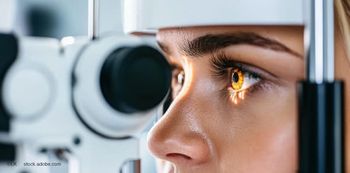
Rapid relief attainable with anti-inflammatory agent
North Arlington, NJ—Loteprednol etabonate 0.2% ophthalmic suspension (Alrex, Bausch & Lomb) provides safe and rapid relief from the entire gamut of symptoms of allergic conjunctivitis, according to John Favetta, MD.
"Based on its speed, safety, and broad-ranging activity, loteprednol etabonate 0.2% is my treatment of choice for the highly symptomatic allergy sufferer," commented Dr. Favetta, who is in private practice in North Arlington, NJ, and the former director of the division of ophthalmology, Clara Maas Medical Center, Belleville, NJ.
He noted that patients with allergic conjunctivitis who present in significant distress are likely already to have tried over-the-counter or prescription antihistamine-decongestant drops. Prescribing loteprednol etabonate 0.2% in that situation is an attractive option because it seems to have an advantage over other anti-allergy products for providing the fastest fix.
Patients are instructed to administer one drop four to six times a day and then taper the frequency of the drop over the next 10 to 14 days.
"Using this corticosteroid for a relatively short period gets the patient through the acute phase of the allergic response with effective control of itching, redness, photophobia, and swelling. Thereafter, many patients can undergo transition to maintenance treatment with an antihistamine/mast cell stabilizer type of product," Dr. Favetta said.
Low risk profile However, for patients with more chronic allergies, such as those with perennial allergic conjunctivitis, Dr. Favetta often continues treatment with loteprednol etabonate 0.2% over a longer term. He noted that he is very comfortable with maintenance therapy using this "designer steroid" because it offers all of the benefits of a corticosteroid whereas the risks of steroid-typical adverse events and complications are very low because it is rapidly degraded to inactive metabolites by esterases in the eye.
In a recent article, Dr. Favetta and co-authors reported on the long-term safety of loteprednol etabonate 0.2% in the treatment of 397 patients with seasonal and perennial allergic conjunctivitis [Ilyas H, et al. Eye Contact Lens 2004;30:10-13]. Of those patients, 159 (40%) had been using the medication continuously for longer than 12 months. Retrospective chart reviews identified no problems with steroid-induced cataract formation, IOP elevations, or infectious disease complications.
"Using loteprednol etabonate 0.2% over the longer term with good follow-up care affords very good results in regard to both efficacy and safety," Dr. Favetta said.
In addition to its excellent safety profile, loteprednol etabonate 0.2% is very comfortable and well tolerated.
"The formulation incorporates a small amount of glycerin, which seems to enhance comfort on instillation, and the frequency of discontinuation because of local side effects is extremely low," Dr. Favetta said.
Newsletter
Don’t miss out—get Ophthalmology Times updates on the latest clinical advancements and expert interviews, straight to your inbox.













































.png)


